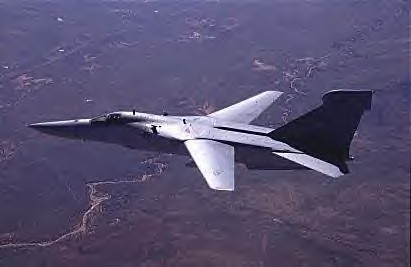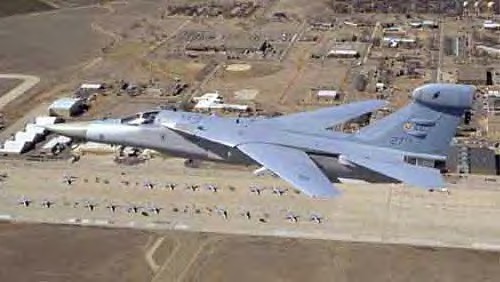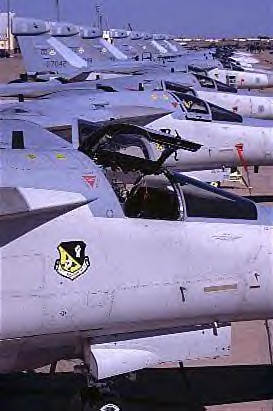Development of the EF-111A Raven ("Spark Varks") began in January 1975 when the Air Force contracted with Grumman Aerospace to modify two F-111As to serve as electronic warfare platforms. The F-111Ēs high speed, long range, substantial payload and reasonable cost made it the ideal candidate to protect allied tactical forces against enemy radar defenses.
The EF-111A provided protection by using a jamming orbit where it stands off from threat radars to cover friendly aircraft entering and leaving the threat areas, or by using the aircraft's high-performance capabilities to directly support attacking forces. In the direct support mission, the Raven may fly as in escort position or enter a threat area to the best jammer position. Ravens engaged in direct support often use the extensive night terrain-following capability built into the basic F-111 design.
Since the EF-111 became operational in 1981, they were involved in every conflict America's had, from Eldorado Canyon in Libya to Desert Storm. In Desert Storm an EF-111 was credited with one of the first kills of the conflict as a maneuvering Raven caused a pursuing Iraqi Mirage to crash into the ground.
When converting the aircraft to its new electronic warfare role, the primary modification was the ALQ-99 jamming system, N/ALQ-137 self-protection system, and an AN/ALR-62 terminal threat warning system. To accommodate the 6,000 pounds of new electronics, Grumman added a narrow, 16-foot long canoe-shaped radome under the fuselage and a din-tip pod mounted on top of the vertical stabilizer.
 Exterior modifications include a narrow canoe-shaped radome, about 16 feet (4.85 meters) long, mounted under the fuselage, which house antennas for the high-powered jamming transmitters. Also, a fin-tip pod is mounted on the reinforced vertical stabilizer to house receiving antennas and ancillary equipment, including a processor to detect hostile radar emissions. The total equipment weight is about 3.5 tons (3,150 kilograms).
Exterior modifications include a narrow canoe-shaped radome, about 16 feet (4.85 meters) long, mounted under the fuselage, which house antennas for the high-powered jamming transmitters. Also, a fin-tip pod is mounted on the reinforced vertical stabilizer to house receiving antennas and ancillary equipment, including a processor to detect hostile radar emissions. The total equipment weight is about 3.5 tons (3,150 kilograms).
Interior modifications include a rearranged cockpit -- the right-seat crew member is an electronic warfare officer responsible for navigation, terrain-following flight and electronic warfare operations. The electronic warfare officer plans jamming tactics in advance, and then programs, operates and monitors the jamming system. Previous radar-jamming aircraft required several operators and more equipment to perform radar-jamming sessions.
The primary electronic countermeasures unit is the AN/ALQ-99E jamming subsystem. It is an improved version of the U.S. Navy's first ALQ-99 jamming subsystem. Improvements to the Navy version include: capability to more rapidly detect and identify enemy transmissions; greater automation (and less reliance on human involvement and manual operations); expanded computer functions providing sophisticated and flexible jamming options; and more independent jamming signals over a wider range of frequencies.
The AN/ALQ-99E detects radar signals, processes them and compares them to known threat radar characteristics stored in an on-board computer. Jamming subsystem receivers scan across frequency bands under computer or manual control. When threats are identified, appropriate countermeasures are initiated. Information about new threats, not in the memory of the computer, can be fed into the system either through entries on the electronic warfare officer's cockpit keyboard or by programming the computer via a cassette that plugs directly into the plane. Changing the programming takes about five minutes if plug-in modules are used. The electronic warfare officer can test the information and, if necessary, make corrections using the keyboard and cockpit display unit.
A self-protection subsystem is designed to protect the EF-111A against radar-directed, anti-aircraft artillery, and missile or aircraft threats.
 The aircraft were updated with modern digital navigation and flight-control systems, which equip the airplane with ring-laser gyro and global-positioning navigation systems, as well as improved controls and displays. The radar and terrain-following flight system were also updated.
The aircraft were updated with modern digital navigation and flight-control systems, which equip the airplane with ring-laser gyro and global-positioning navigation systems, as well as improved controls and displays. The radar and terrain-following flight system were also updated.
Grummanís EF-111A prototypes staged their first flights in 1977. After two years of testing the Air Force gave the contractor the go-ahead to convert 42 F-111As into the EF-111 configuration. The modifications cost approximately $25 million per aircraft, and the total cost of the program was $1.5 billion. The first production EF-111 was delivered to the 388th Tactical Electronic Squadron at Mountain Home AFB, Idaho, in November 1981 and the aircraft became fully operational in 1983.
During Operation Desert Storm all available Ravens were deployed to Middle East bases to support U.S. and allied combat operations. More than 1,300 sorties were flown, with many missions penetrating deep into enemy territory. All major allied air attacks were supported by Ravens that teamed with other Air Force and allied electronic combat units to cause a rapid collapse of the enemy air defense system. One EF-111A was lost during combat.
The Avionics Modernization Program (AMP) included the installation of 10 new subsystems including a doppler radar and internal navigation system. The modification, installed in all 42 EF-111s, was completed in 1994. The first flight of the EF-111A upgraded by the System Improvement Program took place 14 March 1995. The EF-111A SIP was the first major upgrade to the Raven since the aircraft's introduction into the Air Force in 1981. The encoder/processor developed by the EF-111A SIP was a modification to the Raven's ALQ-99E Tactical Jamming System. Consisting of the encoder converter interface, countermeasures computer, digital display indicator, and onboard loader/recorder, the E/P provided the Raven with increased signal processing, memory capacity, processing speed and improved man-machine interface, reliability and maintainability. Prompted by a series of crashes attributable to the failure of the F-111ís original analog flight control system, the installation of Digital Flight Control System begann in 1990 and was completed in 1997.
The last squadron of EF-111s remaining in service, at Cannon AFB, NM, peformed the Suppression of Enemy Air Defense [SEAD] mission. DOD decided to retire the EF-111A jammer and replace it with a new Air Force system, the high speed anti-radiation missile (HARM) targeting system on the F-16C, and the existing Navy electronic warfare aircraft, the EA-6B. Recognizing that too few EA-6B aircraft may be available to meet both Air Force and Navy needs, DOD retained these 12 EF-111s in the active inventory through 1998, when additional upgraded EA-6Bs became available. The Raven's replacement, the Prowler, is a four-seat derivative of the highly successful A-6 Intruder. It features an upgraded version of the same tactical jamming system employed by the Raven. The long airframe life ensures that the EF-111 will be a viable system well into the 21st century.
 Manufacturer: Grumman
Manufacturer: Grumman
Wing span (swept): 32 feet
Wing span: 63 feet
Length: 76 feet
Height: 20 feet
Powerplant: 2 TF30-P-3 afterburning turbofans
Weight (empty): 55,275 lbs
Internal fuel: 32,500 lbs
TOGW: 88,950 lbs
Max speed: 1,230 kt
Cruise speed: 435 kt
Takeoff distance: 5,825 feet
Combat ceiling alt: 44,000 feet
Ferry range: 2000 n miles
